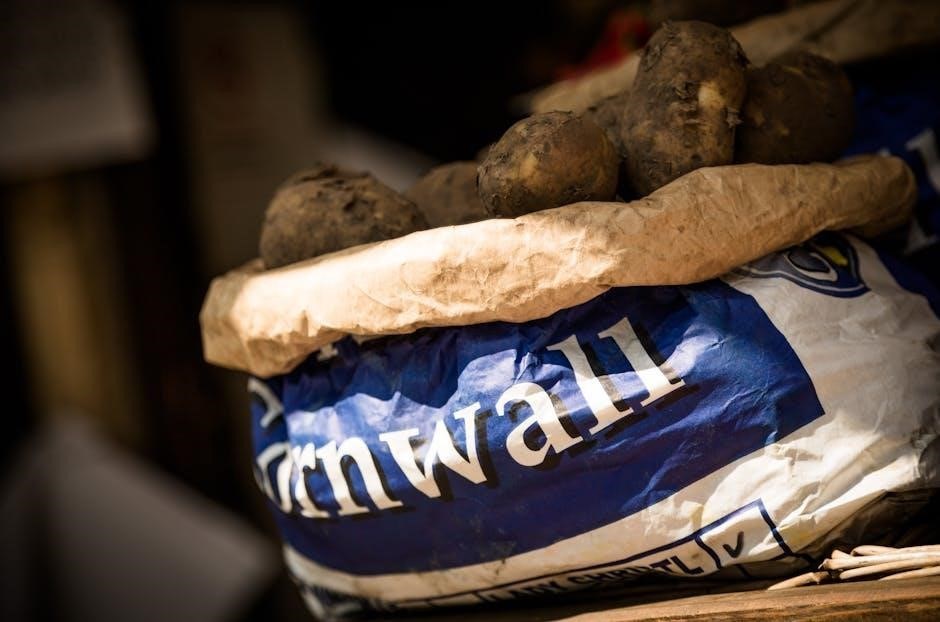Using potato bag instructions is easy with
proper guidance
and techniques for optimal results always.
Understanding the Basics of Growing Potatoes in Bags
To begin growing potatoes in bags, it is essential to understand the basics of this method. Using grow bags allows for better drainage and aeration, which can lead to healthier plants and higher yields. The key is to provide the right conditions for the potatoes to grow, including adequate sunlight, water, and nutrients. By following the proper techniques and guidelines, anyone can successfully grow potatoes in bags. This method is also space-efficient, making it ideal for small gardens or indoor growing. With the right materials and knowledge, growing potatoes in bags can be a fun and rewarding experience. It is crucial to research and understand the basics before starting to ensure the best possible results. Proper planning and execution are vital to a successful harvest. Using online resources and expert advice can help individuals understand the basics of growing potatoes in bags.
Step 1 ⸺ Selecting the Right Size Grow Bags
Choose a minimum of 10-gallon grow bags for optimal potato growth always using.
Importance of Grow Bag Size for Potato Production
The size of the grow bag plays a crucial role in potato production as it affects the yield and quality of the potatoes. A larger grow bag provides more space for the potato plants to grow, resulting in a higher yield. However, it also increases the weight of the potatoes, making it more difficult to handle. On the other hand, a smaller grow bag may limit the growth of the potato plants, resulting in a lower yield. It is essential to choose a grow bag that is large enough to accommodate the potato plants, but not so large that it becomes unwieldy. The ideal size of the grow bag will depend on the variety of potato being grown and the available space. Using the right size grow bag can help to optimize potato production and ensure a successful harvest. Proper planning is necessary to achieve this.

Preparing the Soil for Potato Growth
Soil preparation is key to successful potato growth with proper always used.
Best Soil for Growing Potatoes in Bags
The best soil for growing potatoes in bags is a well-draining and nutrient-rich potting mix or compost-based soil. This type of soil will help to prevent waterlogged soil and root rot, which can be detrimental to potato growth. A good potting mix should contain a mix of peat moss, vermiculite, and perlite, which will help to retain moisture and nutrients. It is also important to avoid using heavy garden soil, as it can compact and inhibit root growth. By using a high-quality potting mix, you can help to ensure healthy and productive potato plants. Additionally, the soil should be loose and friable, allowing for good aeration and root growth. With the right soil, you can expect to see healthy and vigorous potato plants, with a bountiful harvest of delicious potatoes. Proper soil preparation is essential for successful potato growth in bags.

Planting Seed Potatoes in Grow Bags
Planting seed potatoes in grow bags requires proper techniques always using correct methods.
Preparing Seed Potatoes for Planting
To prepare seed potatoes for planting, it is essential to follow specific guidelines to ensure optimal growth and development.
Using the internet as a resource, one can find that chitting is a crucial step in preparing seed potatoes, which involves allowing them to sprout before planting.
This process can be done by placing the seed potatoes in a cool, light location, allowing them to develop short green sprouts.
It is also important to handle the seed potatoes carefully to avoid damaging the sprouts or the tubers.
By following these steps, one can successfully prepare seed potatoes for planting in grow bags, ultimately leading to a healthy and productive crop.
The key to successful seed potato preparation is attention to detail and a thorough understanding of the process, making it easier to grow potatoes in bags.
Proper preparation is vital for a successful harvest.

Adding Soil and Hilling Potato Plants
Adding soil and hilling techniques require patience and
proper
guidance always for optimal results.
Techniques for Adding Soil and Hilling Potato Plants
When adding soil and hilling potato plants, it is essential to leave enough space for the plants to grow and the tubers to form. The soil should be added in layers, with each layer being about 2-3 inches thick, and the plants should be hilled up to about 2/3 of their height. This technique allows the plants to produce more tubers and helps to prevent the soil from becoming too compacted. It is also important to make sure the soil is moist but not waterlogged, as this can cause the tubers to rot. By following these techniques, you can help to ensure a healthy and productive potato crop. Using the right techniques for adding soil and hilling potato plants can make a big difference in the success of your crop. Proper soil and hilling techniques are crucial for optimal results.

Harvesting Potatoes from Grow Bags
Harvest potatoes when plants turn yellow using proper
techniques
always for optimal results.
Timing and Techniques for Harvesting Potatoes
The timing of harvesting potatoes is crucial for optimal flavor and texture, and techniques play a significant role in this process.
Using the right methods, such as gently digging around the plants, can help prevent damage to the tubers.
It is essential to check the plants regularly for signs of maturity, such as yellowing leaves and stems.
When the plants are ready, the potatoes can be carefully lifted out of the grow bags, taking care not to bruise or damage them.
Proper handling and storage of the harvested potatoes are also vital to maintain their quality and freshness.
By following the right timing and techniques, gardeners can enjoy a bountiful harvest of delicious and healthy potatoes from their grow bags.
The entire process requires patience, attention to detail, and a good understanding of the specific needs of potato plants.
With practice and experience, gardeners can refine their techniques and improve their yields.
